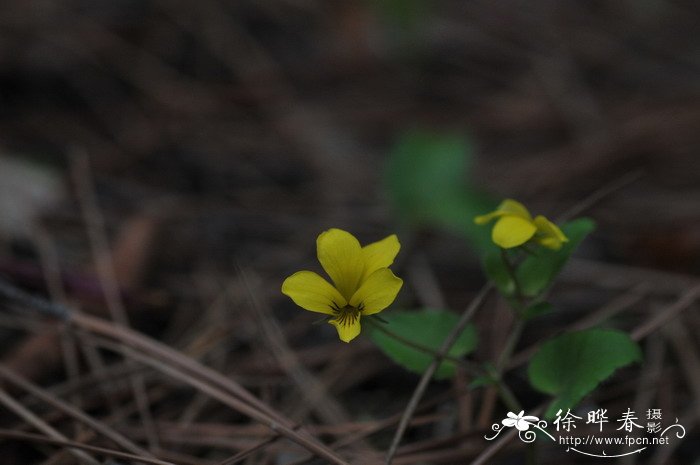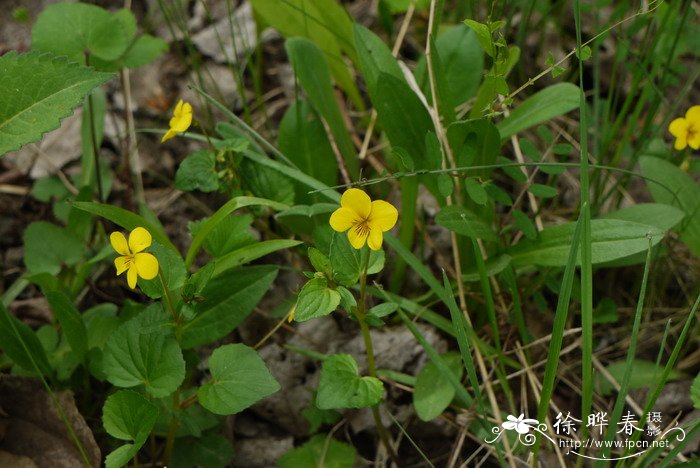灰叶堇菜Viola delavayi
中文名(Chinese Name):灰叶堇菜
学名(Scientific Name):Viola delavayi Franch.
英文名(English Common Name):
别名(Chinese Common Name):
异名(Synonym):Viola impatiens H. Lév. Viola boissieui H. Lév. et Maire Viola delavayi var. villosa W. Becker Viola delavayi f. depauperata Diels
科属(Family & Genus):堇菜科(Violaceae)堇菜属
形态特征(Description):多年生草本。根状茎短粗,具多数暗褐色纤维状根。地上茎直立,高15-25厘米,细弱,无毛,通常不分枝,下部无叶。基生叶通常1枚或缺,叶片厚纸质,卵形,长3-4厘米,宽约3厘米,先端渐尖,基部心形,具波状锯齿缘,齿端具腺点,上面绿色,无毛,下面苍白色,基部疏生长柔毛,具长达7厘米的叶柄;茎生叶叶片较基生叶小,宽卵形或三角状卵形,基部浅心形或截形,上部叶卵状披针形;叶柄长0.5-1厘米,无毛或稀被长柔毛;托叶草质,披针形、长圆形或卵形,长0.5-1.3厘米,下部者比叶柄短1-3倍,上部者等长或超出叶柄,全缘或具疏粗齿。花黄色,由上部叶腋抽出,具长梗;花梗较叶片为长,长约1.5-3厘米,近顶部(紧靠花下)有2枚线形小苞片;萼片线形,长约5毫米,先端尖,无毛或被疏柔毛,基部附属物很短,呈截形;上方花瓣倒卵形,长约1.2厘米,侧方花瓣长约0.9-1厘米,下方花瓣宽倒卵形,长8-9毫米,宽约5毫米,基部有紫色条纹;距极短,长仅0.5-1毫米,末端钝圆;子房卵形,光滑无毛;花柱下部细,上部增粗,柱头2裂,裂片直伸,宽卵形,顶端圆。蒴果小,卵形或近长圆形,长3-4毫米,与宿存的萼片近等长或稍短。花期6-8月,果期7-8月。
分布(Distribution):产四川、贵州、云南,生于海拔1800-2800米的山地林缘、草坡、溪谷潮湿处。
用途(Use):民间以全草入药,能清热解毒;根能治跌打损伤。
引自中国植物志英文版:FOC Vol. 13 Page 105, 107
Viola delavayi Franchet, Bull. Soc. Bot. France. 33: 413. 1886.
灰叶堇菜 hui ye jin cai| Violaceae | Viola
Viola boissieui H. Léveillé & Maire; V. delavayi f. depauperata Diels; V. delavayi var. villosa W. Becker; V. impatiens H. Léveillé.
Herbs perennial. Rhizome short, stout, with numerous dark brown fibrous roots. Stems erect, 15-25 cm tall, slender, glabrous, usually simple, leafless in lower part. Basal leaf usually 1 or absent; petiole to 7 cm; leaf blade abaxially glaucous, adaxially green, ovate, 3-4 × ca. 3 cm, thickly papery, glabrous, abaxially sparsely villous at base, base cordate, margin repand-serrate, apex acuminate. Stipules lanceolate, oblong, or ovate, 0.5-1.3 mm, lower ones 1-3 × shorter than petiole, upper ones subequaling or exceeding petiole, herbaceous, margin entire or remotely and large toothed; cauline leaf petiole 0.5-1 cm, glabrous or rarely villous; cauline leaf blade smaller than those of basal leaves, broadly ovate or triangular-ovate, base shallowly cordate or truncate; upper leaf blade ovate-lanceolate. Flowers in leaf axils at top, yellow, long pedicellate; pedicels exceeding blades, 1.5-3 cm, 2-bracteolate near top; bracteoles linear. Sepals linear, ca. 5 mm, glabrous or sparsely puberulous, apex acute, basal auricles very short, apex truncate. Upper petals obovate, ca. 1.2 cm, lateral ones 0.9-1 cm, anterior one broadly obovate, 8-9.5 mm, base purple striate; spur very short, only 0.5-1 mm, apex obtuse. Ovary ovoid, smooth, glabrous; styles slender in lower part, thickened in upper part; stigmas 2-lobed, lobes spreading, straight, broadly ovate, apex rounded. Capsule ovoid or nearly oblong, small, 3-4 mm, subequaling or slightly shorter than persistent sepals. Fl. May-Aug, fr. Jul-Oct.
● Forest margins on mountains, grassy slopes, moist places in stream valleys; 1800-2800 m. Guizhou, Sichuan, Yunnan.


(责任编辑:徐晔春)
学名(Scientific Name):Viola delavayi Franch.
英文名(English Common Name):
别名(Chinese Common Name):
异名(Synonym):Viola impatiens H. Lév. Viola boissieui H. Lév. et Maire Viola delavayi var. villosa W. Becker Viola delavayi f. depauperata Diels
科属(Family & Genus):堇菜科(Violaceae)堇菜属
形态特征(Description):多年生草本。根状茎短粗,具多数暗褐色纤维状根。地上茎直立,高15-25厘米,细弱,无毛,通常不分枝,下部无叶。基生叶通常1枚或缺,叶片厚纸质,卵形,长3-4厘米,宽约3厘米,先端渐尖,基部心形,具波状锯齿缘,齿端具腺点,上面绿色,无毛,下面苍白色,基部疏生长柔毛,具长达7厘米的叶柄;茎生叶叶片较基生叶小,宽卵形或三角状卵形,基部浅心形或截形,上部叶卵状披针形;叶柄长0.5-1厘米,无毛或稀被长柔毛;托叶草质,披针形、长圆形或卵形,长0.5-1.3厘米,下部者比叶柄短1-3倍,上部者等长或超出叶柄,全缘或具疏粗齿。花黄色,由上部叶腋抽出,具长梗;花梗较叶片为长,长约1.5-3厘米,近顶部(紧靠花下)有2枚线形小苞片;萼片线形,长约5毫米,先端尖,无毛或被疏柔毛,基部附属物很短,呈截形;上方花瓣倒卵形,长约1.2厘米,侧方花瓣长约0.9-1厘米,下方花瓣宽倒卵形,长8-9毫米,宽约5毫米,基部有紫色条纹;距极短,长仅0.5-1毫米,末端钝圆;子房卵形,光滑无毛;花柱下部细,上部增粗,柱头2裂,裂片直伸,宽卵形,顶端圆。蒴果小,卵形或近长圆形,长3-4毫米,与宿存的萼片近等长或稍短。花期6-8月,果期7-8月。
分布(Distribution):产四川、贵州、云南,生于海拔1800-2800米的山地林缘、草坡、溪谷潮湿处。
用途(Use):民间以全草入药,能清热解毒;根能治跌打损伤。
引自中国植物志英文版:FOC Vol. 13 Page 105, 107
Viola delavayi Franchet, Bull. Soc. Bot. France. 33: 413. 1886.
灰叶堇菜 hui ye jin cai| Violaceae | Viola
Viola boissieui H. Léveillé & Maire; V. delavayi f. depauperata Diels; V. delavayi var. villosa W. Becker; V. impatiens H. Léveillé.
Herbs perennial. Rhizome short, stout, with numerous dark brown fibrous roots. Stems erect, 15-25 cm tall, slender, glabrous, usually simple, leafless in lower part. Basal leaf usually 1 or absent; petiole to 7 cm; leaf blade abaxially glaucous, adaxially green, ovate, 3-4 × ca. 3 cm, thickly papery, glabrous, abaxially sparsely villous at base, base cordate, margin repand-serrate, apex acuminate. Stipules lanceolate, oblong, or ovate, 0.5-1.3 mm, lower ones 1-3 × shorter than petiole, upper ones subequaling or exceeding petiole, herbaceous, margin entire or remotely and large toothed; cauline leaf petiole 0.5-1 cm, glabrous or rarely villous; cauline leaf blade smaller than those of basal leaves, broadly ovate or triangular-ovate, base shallowly cordate or truncate; upper leaf blade ovate-lanceolate. Flowers in leaf axils at top, yellow, long pedicellate; pedicels exceeding blades, 1.5-3 cm, 2-bracteolate near top; bracteoles linear. Sepals linear, ca. 5 mm, glabrous or sparsely puberulous, apex acute, basal auricles very short, apex truncate. Upper petals obovate, ca. 1.2 cm, lateral ones 0.9-1 cm, anterior one broadly obovate, 8-9.5 mm, base purple striate; spur very short, only 0.5-1 mm, apex obtuse. Ovary ovoid, smooth, glabrous; styles slender in lower part, thickened in upper part; stigmas 2-lobed, lobes spreading, straight, broadly ovate, apex rounded. Capsule ovoid or nearly oblong, small, 3-4 mm, subequaling or slightly shorter than persistent sepals. Fl. May-Aug, fr. Jul-Oct.
● Forest margins on mountains, grassy slopes, moist places in stream valleys; 1800-2800 m. Guizhou, Sichuan, Yunnan.
(责任编辑:徐晔春)
踩一下[0]

顶一下[0]